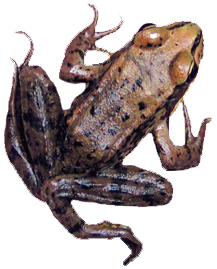January 12 - 16, 2016
January 12, 2016 - Heavy rain and a warming trend forecasted for the week has the frog cab company on its toes again. There are at least 113 females down in the pond, since we ferried them down from Harborton December 7 and 8, plus those who made it on their own. Since the females don’t hang around long in the pond after their eggs are deposited, and they’ve been down there five weeks now, we’re expecting frogs to go both down from the forest and up. 43 degrees F at sunset, and a little cool for migration, only one male was caught on Harborton, and one female on Marina Way, both frogs caught 1 1/2 to 2 hours after sunset, so they were perhaps a little tentative, not moving as soon as it was dark. (Big migrations usually explode at dark, the frogs jumping at their chance.) Panos was crew leader, doing a great job of hanging in there till he could be sure of what the frog’s were doing. I happened to be going home, walking up Harborton at 7:45, shortly after Panos left, and didn’t see any frogs. Tomorrow night is supposed to be warmer, so we’re getting excited, though the frogs probably take the weather as it comes, calmly.
January 13, 2016 - A misty night with the temperature hovering around the usual cut off for frog movement -- 45 degrees F. After this long frog lull we expect the frogs to be impatient and ready to migrate if the conditions are remotely favorable, but they apparently bide their time. Sue’s crew caught 20 early in the evening, mostly along St Helens Road, coming down the cliffs.
January 14, 2016 - 43 and light rain at dusk, Jeff’s crew hangs in along the dark roads for a couple hours, catching one frog not long before they leave.
January 15, 2016 - Temp lingering at 45 with very light rain, no frogs, the weather continuing to tease us.
January 16, 2016 - Expecting the females who came down in early December to head back to the forest soon, since they have no reason to stay in the pond after depositing their eggs, we install a hundred feet of the new fabric fencing on Marina Way during the afternoon to make catching the hopsters easier. Rain all day, sometimes heavy, stops late in the warm afternoon. By 5 PM, when my new crew assembles on Harborton Drive (this is the first Saturday -- our night to frog -- my team has come out since Jane put these teams and schedule together early in December, so it’s the first time we’re meeting each other). The temp is 50 but the clear sky shines off the wet, black pavement. The forecast is for a rainy night so we anticipate a big night; Sue came out and is down at Marina Way. In the next 3 1/2 hours we catch 27 males, 4 females and a treefrog, all on Harborton, and all up the road past the falls and down where the road curves to meet the St Helens Road. We don’t see any along the highway, where they were being caught on the 13th. Perhaps we should make an effort to see if there are egg masses down in the pond; might the frogs wait out the cold weather to deposit eggs, as freezing cold will destroythe eggs? My new crew is great; eager, knowledgable, dedicated, fun. Katie Clifford and Linda Zahl caught a quite a few up past the falls.

















